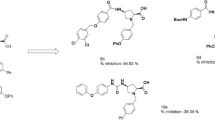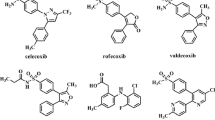Abstract
Inhibitors selective towards the second isoform of prostaglandin synthase (cyclooxygenase, COX-2) are promising nonsteroidal anti-inflammatory drugs and antitumor medications. Methylation of the carboxylate group in the relatively nonselective COX inhibitor indomethacin confers significant COX-2 selectivity. Several other modifications converting indomethacin into a COX-2 selective inhibitor have been reported. Earlier experimental and computational studies on neutral indomethacin derivatives suggest that the methyl ester derivative likely binds to COX-2 with a similar binding mode as that observed for the parent indomethacin. However, docking studies followed by molecular dynamics simulations revealed two possible binding modes in COX-2 for indomethacin methyl ester, which differs from the experimental binding mode found for indomethacin. Both alternative binding modes might explain the observed COX-2 selectivity of indomethacin methyl ester.

Binding of indomethacin methyl ester to cyclooxygenase-2





Similar content being viewed by others
References
Simmons DL, Botting RM, Hla T (2004) Cyclooxygenase isozymes: the biology of prostaglandin synthesis and inhibition. Pharmacol Rev 56:387–437. https://doi.org/10.1124/pr.56.3.3
Michaux C, Charlier C (2004) Structural approach for COX-2 inhibition. Mini-Rev Med Chem 4:603–615. https://doi.org/10.2174/1389557043403756
Kalgutkar AS, Crews BC, Rowlinson SW et al (2000) Biochemically based design of cyclooxygenase-2 (COX-2) inhibitors: facile conversion of nonsteroidal antiinflammatory drugs to potent and highly selective COX-2 inhibitors. Proc Natl Acad Sci USA 97:925–930. https://doi.org/10.1073/pnas.97.2.925
Blobaum AL, Marnett LJ (2007) Structural and functional basis of cyclooxygenase inhibition. J Med Chem 50:1425–1441. https://doi.org/10.1021/jm0613166
Sidhu RS, Lee JY, Yuan C, Smith WL (2010) Comparison of cyclooxygenase-1 crystal structures: cross-talk between monomers comprising cyclooxygenase-1 homodimers. Biochemistry 49:7069–7079. https://doi.org/10.1021/bi1003298
Kalgutkar AS, Marnett AB, Crews BC et al (2000) Ester and amide derivatives of the nonsteroidal antiinflammatory drug, indomethacin, as selective cyclooxygenase-2 inhibitors. J Med Chem 43:2860–2870. https://doi.org/10.1021/jm000004e
Hess S, Teubert U, Ortwein J, Eger K (2001) Profiling indomethacin impurities using high-performance liquid chromatography and nuclear magnetic resonance. Eur J Pharm Sci 14:301–311. https://doi.org/10.1016/S0928-0987(01)00198-1
Kurumbail RG, Stevens AM, Gierse JK et al (1996) Structural basis for selective inhibition of cyclooxygenase-2 by anti-inflammatory agents. Nature 384:644–648. https://doi.org/10.1038/384644a0
Konkle ME, Blobaum AL, Moth CW et al (2016) Conservative secondary shell substitution in cyclooxygenase-2 reduces inhibition by indomethacin amides and esters via altered enzyme dynamics. Biochemistry 55:348–359. https://doi.org/10.1021/acs.biochem.5b01222
Kozak KR, Prusakiewicz JJ, Rowlinson SW, Marnett LJ (2002) Enantiospecific, selective cyclooxygenase-2 inhibitors. Bioorg Med Chem Lett 12:1315–1318. https://doi.org/10.1016/S0960-894X(02)00133-6
Moth CW, Prusakiewicz JJ, Marnett LJ, Lybrand TP (2005) Stereoselective binding of indomethacin ethanolamide derivatives to cyclooxygenase-1. J Med Chem 48:3613–3620. https://doi.org/10.1021/jm0494164
Harman CA, Turman MV, Kozak KR et al (2007) Structural basis of enantioselective inhibition of cyclooxygenase-1 by S-α-substituted indomethacin ethanolamides. J Biol Chem 282:28096–28105. https://doi.org/10.1074/jbc.M701335200
Gierse JK, Koboldt CM, Walker MC et al (1999) Kinetic basis for selective inhibition of cyclo-oxygenases. Biochem J 339:607–614. https://doi.org/10.1042/bj3390607
Walker MC, Kurumbail RG, Kiefer JR et al (2001) A three-step kinetic mechanism for selective inhibition of cyclo-oxygenase-2 by diarylheterocyclic inhibitors. Biochem J 357:709–718. https://doi.org/10.1042/bj3570709
Neumann W, Xu S, Sárosi MB et al (2016) nido-Dicarbaborate induces potent and selective inhibition of cyclooxygenase-2. Chem Med Chem 11:175–178. https://doi.org/10.1002/cmdc.201500199
Xu S, Hermanson DJ, Banerjee S et al (2014) Oxicams bind in a novel mode to the cyclooxygenase active site via a two-water-mediated H-bonding network. J Biol Chem 289:6799–6808. https://doi.org/10.1074/jbc.M113.517987
Xu S, Rouzer CA, Marnett LJ (2014) Oxicams, a class of nonsteroidal anti-inflammatory drugs and beyond. IUBMB Life 66:803–811. https://doi.org/10.1002/iub.1334
Limongelli V, Bonomi M, Marinelli L et al (2010) Molecular basis of cyclooxygenase enzymes (COXs) selective inhibition. Proc Natl Acad Sci USA 107:5411–5416. https://doi.org/10.1073/pnas.0913377107
Dennington R, Keith T, Millam J (2009) GaussView. Semichem Inc., Shawnee Mission, KS
Frisch MJ, Trucks GW, Schlegel HB et al (2009) Gaussian 09, Revision A.02. Gaussian, Inc., Wallingford
Singh UC, Kollman PA (1984) An approach to computing electrostatic charges for molecules. J Comput Chem 5:129–145. https://doi.org/10.1002/jcc.540050204
Besler BH, Merz KM, Kollman PA (1990) Atomic charges derived from semiempirical methods. J Comput Chem 11:431–439. https://doi.org/10.1002/jcc.540110404
Bayly CI, Cieplak P, Cornell W, Kollman PA (1993) A well-behaved electrostatic potential based method using charge restraints for deriving atomic charges: the RESP model. J Phys Chem 97:10269–10280. https://doi.org/10.1021/j100142a004
Case DA, Darden TA, Cheatham III TE et al (2012) AMBER 13. University of California, San Francisco
Wang JL, Limburg D, Graneto MJ et al (2010) The novel benzopyran class of selective cyclooxygenase-2 inhibitors. Part 2: the second clinical candidate having a shorter and favorable human half-life. Bioorg Med Chem Lett 20:7159–7163. https://doi.org/10.1016/j.bmcl.2010.07.054
Pettersen EF, Goddard TD, Huang CC et al (2004) UCSF chimera—a visualization system for exploratory research and analysis. J Comput Chem 25:1605–1612. https://doi.org/10.1002/jcc.20084
Morris GM, Huey R, Lindstrom W et al (2009) AutoDock4 and AutoDockTools4: automated docking with selective receptor flexibility. J Comput Chem 30:2785–2791. https://doi.org/10.1002/jcc.21256
Morris GM, Goodsell DS, Halliday RS et al (1998) Automated docking using a Lamarckian genetic algorithm and an empirical binding free energy function. J Comput Chem 19:1639–1662. https://doi.org/10.1002/(SICI)1096-987X(19981115)19:14<1639::AID-JCC10>3.0.CO;2-B
Hornak V, Abel R, Okur A et al (2006) Comparison of multiple amber force fields and development of improved protein backbone parameters. Proteins 65:712–725. https://doi.org/10.1002/prot.21123
Wang J, Wolf RM, Caldwell JW et al (2004) Development and testing of a general amber force field. J Comput Chem 25:1157–1174. https://doi.org/10.1002/jcc.20035
Furse KE, Pratt DA, Porter NA, Lybrand TP (2006) Molecular dynamics simulations of arachidonic acid complexes with cox-1 and cox-2: insights into equilibrium behavior. Biochemistry 45:3189–3205. https://doi.org/10.1021/bi052337p
Berendsen HJC, Grigera JR, Straatsma TP (1987) The missing term in effective pair potentials. J Phys Chem 91:6269–6271. https://doi.org/10.1021/j100308a038
Ryckaert J-P, Ciccotti G, Berendsen HJ (1977) Numerical integration of the Cartesian equations of motion of a system with constraints: molecular dynamics of n-alkanes. J Comput Phys 23:327–341. https://doi.org/10.1016/0021-9991(77)90098-5
Izaguirre JA, Catarello DP, Wozniak JM, Skeel RD (2001) Langevin stabilization of molecular dynamics. J Chem Phys 114:2090–2098
Götz AW, Williamson MJ, Xu D et al (2012) Routine microsecond molecular dynamics simulations with AMBER on GPUs. 1. Generalized born. J Chem Theory Comput 8:1542–1555. https://doi.org/10.1021/ct200909j
Salomon-Ferrer R, Götz AW, Poole D et al (2013) Routine microsecond molecular dynamics simulations with AMBER on GPUs. 2. Explicit solvent particle mesh Ewald. J Chem Theory Comput 9:3878–3888. https://doi.org/10.1021/ct400314y
Le Grand S, Götz AW, Walker RC (2013) SPFP: speed without compromise—a mixed precision model for GPU accelerated molecular dynamics simulations. Comput Phys Commun 184:374–380. https://doi.org/10.1016/j.cpc.2012.09.022
Cerutti DS, Duke R, Freddolino PL et al (2008) A vulnerability in popular molecular dynamics packages concerning Langevin and Andersen dynamics. J Chem Theory Comput 4:1669–1680. https://doi.org/10.1021/ct8002173
Roe DR, Cheatham TE (2013) PTRAJ and CPPTRAJ: software for processing and analysis of molecular dynamics trajectory data. J Chem Theory Comput 9:3084–3095. https://doi.org/10.1021/ct400341p
Miller BR, McGee TD, Swails JM et al (2012) MMPBSA.py: an efficient program for end-state free energy calculations. J Chem Theory Comput 8:3314–3321. https://doi.org/10.1021/ct300418h
Tan C, Yang L, Luo R (2006) How well does Poisson−Boltzmann implicit solvent agree with explicit solvent? A quantitative analysis. J Phys Chem B 110:18680–18687. https://doi.org/10.1021/jp063479b
Tan C, Tan Y-H, Luo R (2007) Implicit nonpolar solvent models. J Phys Chem B 111:12263–12274. https://doi.org/10.1021/jp073399n
Floris F, Tomasi J (1989) Evaluation of the dispersion contribution to the solvation energy. A simple computational model in the continuum approximation. J Comput Chem 10:616–627. https://doi.org/10.1002/jcc.540100504
Hou T, Wang J, Li Y, Wang W (2010) Assessing the performance of the MM/PBSA and MM/GBSA methods. 1. The accuracy of binding free energy calculations based on molecular dynamics simulations. J Chem Inf Model 51:69–82. https://doi.org/10.1021/ci100275a
Genheden S, Ryde U (2015) The MM/PBSA and MM/GBSA methods to estimate ligand-binding affinities. Expert Opin Drug Discovery 10:449–461. https://doi.org/10.1517/17460441.2015.1032936
Acknowledgments
This work was supported by the European Union, the Free State of Saxony, and the German Research Foundation (DFG, SA 2902/2-1). Some of the computations were performed on a Bull Cluster at the Center for Information Services and High Performance Computing (ZIH) at Technische Universität Dresden. Molecular graphics were rendered using UCSF Chimera [26]. M-B.S. is grateful to Prof. Dr. Evamarie Hey-Hawkins and Prof. Terry P. Lybrand for their collaboration and support.
Author information
Authors and Affiliations
Corresponding author
Additional information
This paper belongs to Topical Collection 11th European Conference on Theoretical and Computational Chemistry (EuCO-TCC 2017)
Electronic supplementary material
ESM 1
(PDF 453 kb)
Rights and permissions
About this article
Cite this article
Sárosi, MB. Binding of indomethacin methyl ester to cyclooxygenase-2. A computational study. J Mol Model 24, 150 (2018). https://doi.org/10.1007/s00894-018-3686-8
Received:
Accepted:
Published:
DOI: https://doi.org/10.1007/s00894-018-3686-8




